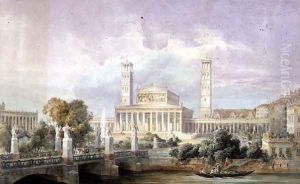Friedrich August von Stuler Paintings
Friedrich August Stüler was an influential Prussian architect and a student of the famous classicist architect Karl Friedrich Schinkel. Born on January 28, 1800, in Mühlhausen, Prussia (present-day Germany), Stüler developed a keen interest in architecture at an early age, which led him to Berlin to study under Schinkel. Under Schinkel's tutelage, Stüler honed his skills and absorbed the neoclassical style that was prevalent in Prussia at the time.
After completing his studies, Stüler embarked on extensive travels through Greece and Italy between 1826 and 1830, where he studied ancient architecture and the Renaissance buildings of Italy. These travels significantly influenced his architectural style by combining the neoclassical principles he learned from Schinkel with the Renaissance and Byzantine elements he observed in Southern Europe.
Stüler's career spanned various roles, including his appointment as the court architect to King Frederick William IV of Prussia in 1842. He was also a member of the Prussian Academy of Arts and took over Schinkel's position as the head of the Higher Architectural Council. Stüler's contribution to architecture extended beyond designing individual buildings; he played a central role in the planning and development of Berlin as a city.
Among his many works, Stüler is best known for his designs of the Neues Museum in Berlin, which was completed in 1859 and showcased his ability to blend different architectural styles harmoniously. He also designed the Nikolai Church in Potsdam and numerous other churches, museums, and public buildings across Prussia. His work is marked by a clear, structured form and a balance between functionalism and ornamentation.
Stüler's legacy is not only in the buildings he designed but also in the influence he exerted on the next generation of architects. His approach to design and his teachings helped shape the architectural landscape of Prussia and Germany during the 19th century. Friedrich August Stüler passed away on March 18, 1865, in Berlin, leaving behind a rich heritage of architectural works that continue to be studied and admired.
